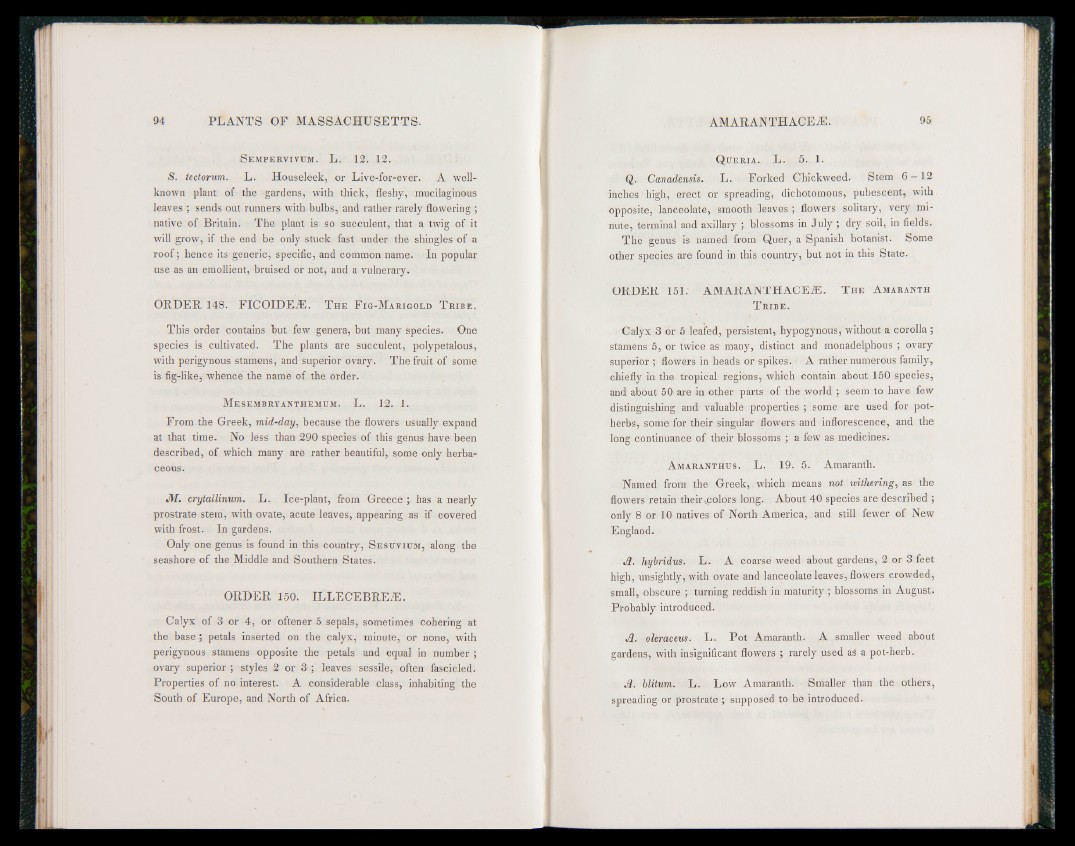
S empervivum. L. 12. 12.
iS. tectorum. L. Houseleek, or Live-for-ever. A well-
known plant of the gardens, with thick, fleshy, mucilaginous
leaves ; sends out runners with bulbs, and rather rarely flowering ;
native of Britain. The plant is so succulent, that a twig of it
will grow, if the end be only stuck fast under the shingles of a
roof; hence its generic, specific, and common name. In popular
use as an emollient, bruised or not, and a vulnerary.
ORDER 148. F IC O ID E iE . T he F ig-Marigold T r i b e .
This order contains but few genera, but many species. One
species is cultivated. The plants are succulent, polypetalous,
with perigynous stamens, and superior ovary. The fruit of some
is fig-like, whence the name of the order.
Mesembrtanthemum. L. 12. 1.
From the Greek, mid-day, because the flowers usually expand
at that time. No less than 290 species of this genus have been
described, of which many are rather beautiful, some only herbaceous.
M . crytallinum. L. Ice-plant, from Greece ; has a nearly
prostrate stem, with ovate, acute leaves, appearing as if covered
with frost. In gardens.
Only one genus is found in this country, S esuvium, along the
seashore of the Middle and Southern States.
ORDER 150. IL LEC EB REiE.
Calyx of 3 or 4, or oftener 5 sepals, sometimes cohering at
the base ; petals inserted on the calyx, minute, or none, with
perigynous stamens opposite the petals and equal in number ;
ovary superior; styles 2 or 3 ; leaves sessile, often fascicled.
Properties of no interest. A considerable class, inhabiting the
South of Europe, and North of Africa.
Q ueria. L. 5. 1.
Q. Canadensis. L. Forked Chickweed. Stem 6 — 12
inches high, erect or spreading, dichotomous, pubescent, with
opposite, lanceolate, smooth leaves ; flowers solitary, very minute,
terminal and axillary ; blossoms in July ; dry soil, in fields.
The genus is named from Quer, a Spanish botanist. Some
other species are found in this country, but not in this State.
ORDER 151. AMARANTHACEiE. T he Amaranth
T ribe.
Calyx 3 or 5 leafed, persistent, hypogynous, without a corolla ;
stamens 5, or twice as many, distinct and monadelphous ; ovary
superior ; flowers in heads or spikes. A rather numerous family,
chiefly in the tropical regions, which contain about 150 species,
and about 50 are in other parts of the world ; seem to have few
distinguishing and valuable properties ; some are used for potherbs,
some for their singular flowers and inflorescence, and the
long continuance of their blossoiDs ; a few as medicines.
Amaranthus. L. 19. 5. Amaranth.
Named from the Greek, which means not withering, as the
flowers retain their ^colors long. About 40 species are described ;
only 8 or 10 natives of North America, and still fewer of New
England.
Jl. hybridus. L. A coarse weed about gardens, 2 or 3 feet
high, unsightly, with ovate and lanceolate leaves, flowers crowded,
small, obscure ; turning reddish in maturity ; blossoms in August.
Probably introduced.
A. oleraceus. L. Pot Amaranth. A smaller weed about
gardens, with insignificant flowers ; rarely used a£ a pot-herb.
A. blitum. L. Low Amaranth. Smaller than the others,
spreading or prostrate ; supposed to be introduced.